The Million Pound Donors Report 2011 - Coutts
The Million Pound Donors Report 2011 - Coutts
The Million Pound Donors Report 2011 - Coutts
You also want an ePaper? Increase the reach of your titles
YUMPU automatically turns print PDFs into web optimized ePapers that Google loves.
Discussion<br />
the million pound donors report <strong>2011</strong><br />
| 03 |<br />
Discussion<br />
a. <strong>The</strong> growing prominence of local giving<br />
This is intended to counter the cynicism about the<br />
motivations of major donors that persists in the UK –<br />
particularly in some sections of the media. A significant<br />
example is the creation of a new philanthropy committee<br />
to review candidates for honours.<br />
Non-governmental philanthropy initiatives<br />
<strong>The</strong> past twelve months have also seen a variety of<br />
pro-philanthropic activity outside government.<br />
For example, Philanthropy UK, the leading resource for<br />
free and impartial advice to aspiring philanthropists, has<br />
attracted ongoing funding for its work, and re-launched its<br />
website at www.philanthropyuk.org<br />
<strong>The</strong> most high profile non-governmental initiative of <strong>2011</strong><br />
was <strong>The</strong> Philanthropy Review, a sector-led inquiry, which<br />
sought to encourage more giving by a larger number of<br />
people. <strong>The</strong> Philanthropy Review was launched in<br />
December 2010 and published its final report in June <strong>2011</strong>,<br />
which contained three sets of specific proposals:<br />
1. Making it easier to give, for example by promoting<br />
payroll giving and establishing charity bank accounts.<br />
2. Encouraging giving, for example by extending tax<br />
breaks to donations of all types of assets and by<br />
introducing Lifetime Legacies 9 .<br />
3. Changing the culture of giving, for example by<br />
educating a larger number of children about giving from<br />
an earlier age, and by launching a national campaign<br />
called Give More to galvanise support for charities<br />
during these difficult economic times.<br />
Although the inquiry has finished, a core group of <strong>The</strong><br />
Philanthropy Review will continue to meet to oversee<br />
implementation of its recommendations. It is therefore<br />
likely to continue to be a key player in the philanthropy<br />
sector in the coming year, not least because it has<br />
earmarked 2012 as ‘a year where giving is celebrated, where<br />
more people think about what they give and where those<br />
who can, pledge to give more’.<br />
Local philanthropy gives donors the opportunity to make<br />
a contribution to a community that matters to them<br />
personally, whether it be the area where they grew up,<br />
built their business, raised a family or have a special<br />
connection for some other reason.<br />
This type of philanthropy has risen in prominence during<br />
<strong>2011</strong>, and promises to continue to attract attention into<br />
2012 and beyond. Efforts to promote local philanthropy are<br />
being initiated in a wide variety of sectors including the<br />
government, the media, charities and corporations, as the<br />
following three examples show.<br />
One of the most prominent geographically defined<br />
philanthropic initiatives that has arisen in recent years is<br />
the London Dispossessed Fund, organised by the Evening<br />
Standard newspaper. Begun in summer 2010, it has now<br />
raised over £7 million to address the causes and effects of<br />
poverty in the capital city. <strong>The</strong> riots of <strong>2011</strong>, which started<br />
in London and caused greatest damage in areas already<br />
experiencing high levels of deprivation - such as<br />
Tottenham and Lewisham – brought new momentum,<br />
and monies are now being distributed to riot-hit areas.<br />
<strong>The</strong> fund is being run in partnership with Community<br />
Foundation Network (CFN), whose chief executive,<br />
Stephen Hammersley, says:<br />
“This initiative tapped into the desire of Londoners<br />
to make a difference. Some of the well-off gave<br />
significant sums and many others gave smaller<br />
amounts. People also volunteered, and community<br />
groups were equipped to change people’s lives for the<br />
better as a result. This goes on around the country all<br />
the time, enabled by community foundations. In<br />
London, the partnership with the London Evening<br />
Standard newspaper - which ran a series of stories<br />
highlighting the plight of disadvantaged Londoners –<br />
provided the oxygen of publicity and profile that took<br />
it to a new level.”<br />
CFN is also spearheading a new three-year project to<br />
transform local philanthropy across the UK. <strong>The</strong> Esmée<br />
Fairbairn Foundation is funding the initiative to the tune<br />
of £750,000 to mark its own 50th anniversary. This will<br />
be used to create a fellowship of local philanthropists.<br />
Activities will include donor education and donor<br />
networking events, with the ultimate aim of strengthening<br />
the culture of local giving across the UK. Commenting on<br />
this initiative, Clare Brooks, Director of Philanthropy at<br />
CFN, says:<br />
“<strong>The</strong> idea of creating a fellowship of local<br />
philanthropists came about as a response to the<br />
realisation that sociability and conviviality make<br />
philanthropy more attractive to potential donors.<br />
<strong>Donors</strong> really do enjoy getting together and swapping<br />
stories, contacts, skills and information. We are<br />
delighted that <strong>The</strong> Esmée Fairbairn Foundation has<br />
chosen to support this initiative, and are convinced<br />
it will help to encourage more and better giving.”<br />
In September <strong>2011</strong> a new report focused on local<br />
philanthropy was published by <strong>Coutts</strong>. Inspiring Local<br />
Philanthropy: Making a difference in local communities was<br />
produced as a result of the many conversations <strong>Coutts</strong><br />
has with clients who want to support the communities<br />
they care about.<br />
<strong>The</strong> report highlights the contribution of philanthropy to<br />
local communities, showing donors how to get started, and<br />
sharing inspiring approaches and stories. One of the donors<br />
featured in the report is Andrew Preston, who created his<br />
wealth by working in the financial sector in London, before<br />
returning to live and concentrate his giving in his home<br />
town of Middlesborough. He is quoted as saying: “I just<br />
feel a sense of pride about where I grew up and I think it is<br />
my duty to help the community.”<br />
<strong>The</strong> report also includes a profile of Peter Saunders OBE,<br />
who lives and has built his business in rural Wales, where<br />
he now channels his charitable activity. He describes some<br />
of the many advantages of focusing philanthropy on a local<br />
geographic area: “<strong>The</strong> great thing about giving locally is<br />
that you have intimate knowledge of that area. This means<br />
that you can select what you fund wisely, get involved with<br />
the causes and influence what happens with the funding”.<br />
<strong>The</strong> case studies of million pound donors contained in all<br />
editions of the <strong>Million</strong> <strong>Pound</strong> <strong>Donors</strong> <strong>Report</strong> show that<br />
many of the nation’s biggest donors focus their giving on a<br />
particular geographical area.<br />
<strong>The</strong> charitable trust established by Mary Cornish,<br />
profiled in this edition of the <strong>Million</strong> <strong>Pound</strong> <strong>Donors</strong><br />
<strong>Report</strong>, gives to projects in Yorkshire. This focus is<br />
described as a result of both practical and personal factors<br />
that are relevant to herself as a donor and to her fellow<br />
trustees, as she explains: “We all just decided it would be<br />
a lot tidier and a lot more personal to us if we restricted it<br />
to the county where we lived and worked”.<br />
Mary Cornish also says the geographical restriction makes<br />
it easier to visit projects, either during the application<br />
process or after funding has been provided, to see how the<br />
work is progressing. <strong>The</strong> opportunity to see the projects<br />
they have funded in action and to meet staff, volunteers<br />
and beneficiaries, is often cited as important for donors.<br />
In sum, local giving is viewed by many philanthropists as<br />
an especially satisfying way to support the causes they<br />
care about, because it makes the philanthropy more<br />
meaningful, which in turn can make it more real, inspiring<br />
and enjoyable.<br />
18<br />
19


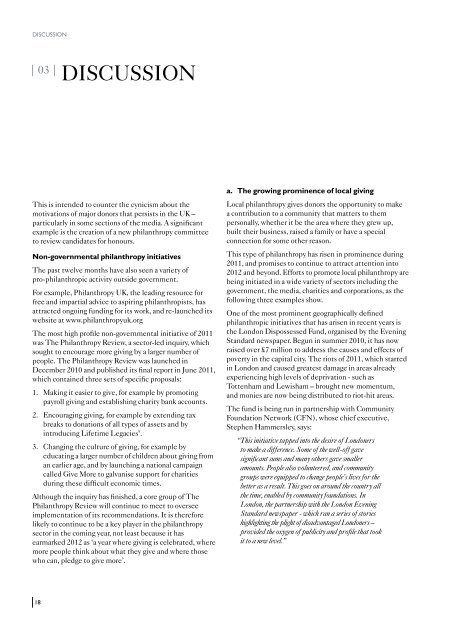
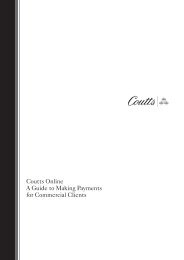
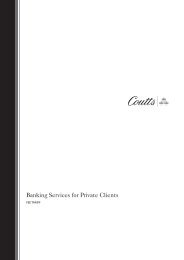
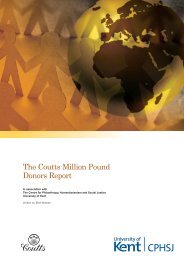
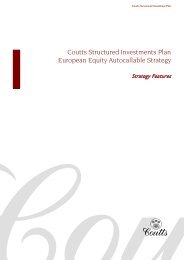




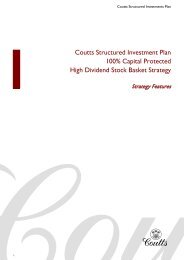
![[PDF] Governance in the Family Business - Coutts](https://img.yumpu.com/36912267/1/184x260/pdf-governance-in-the-family-business-coutts.jpg?quality=85)


